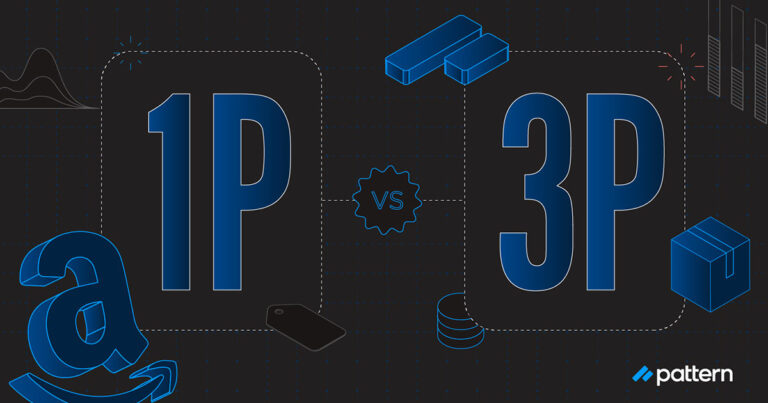If you’ve ever seen your prices on Amazon or other digital marketplaces like Walmart, Target, or eBay drop below the selling price you’ve set, you understand how frustrating price erosion can be for your brand. On top of that, price erosion hurts your sales and profits—but it doesn’t have to be this way.
At Pattern, we are passionate about helping brands stabilize their prices across all selling channels, both online and in-store. Let’s break down what price erosion is, how it impacts your brand, how it happens, and how to stop it.
What is Price Erosion?
Price erosion is when your product’s prices are lowered by another seller online or on ecommerce marketplaces like Amazon, Walmart, or Target. But price erosion isn’t unique to online sales, the lowered prices also trickle out to your retail partners and brick and mortar customers. You see, as one seller lowers their price to make a quick sale, other sellers are forced to lower their price to compete, creating an uncontrolled race to the bottom.
How Price Erosion Impacts Your Brand’s Sales, Profits, and Brand Equity
Price erosion affects your business on much more than the listing price. Sales, profits, and brand equity are all hit when you don’t take control of price erosion on digital marketplaces.
Price Erosion Impacts Sales
When faced with the option to buy the same product at a lower price, customers will almost always choose the lower price—even if it means putting a product back on the store shelf to order online. Marketplaces like Amazon and Walmart know this and want to always provide the lowest price to attract and keep customers. For example, price plays a key role in Amazon’s algorithm for search rank and Buy Box ownership, giving unauthorized sellers a leg up to convert the sale when they break your price.
Price Erosion Impacts Profits
When customers flock to other sellers who offer a lower price, your brand immediately loses sales, but that’s not where the problems end. If you choose to lower your listed price to regain sales, you will find yourself in a game of price-chicken, with the price lowering until you can no longer make a profit online.
But you still have brick and mortar, right?
Brick and mortar stores are faced with the same dilemma. If they don’t lower the prices of your products they lose the sale, which also erodes their profits. If this problem continues, your retail partners will get mad. Many times brick and mortar retailers start price-matching programs, allowing stores to match online prices while your brand foots the bill for the difference. Unfortunately, this still ends with your brand losing profits in an attempt to capture low price sales.
Price Erosion Impacts Brand Equity
Once price erosion happens, it’s difficult to regain profitably on Amazon and other retail channels, but it may be even more difficult to regain brand equity. Brand equity is the perceived value a customer has for a brand, which determines the price they are willing to pay for products. Brands typically build great margins because of what their brand represents to the consumer.
Brand equity erodes when consumers see your price lower online or other channels. As customers continually find lower prices online, they come to expect the promotional/discounted prices and opt to wait to buy new, full-price items. This hurts long-term sales, margin and profit.
How Price Erosion Happens
Price erosion can happen on any digital marketplace. Let’s talk about how it typically happens on Amazon.
Amazon’s algorithm looks at your product and scrapes the internet looking for a lower price. If Amazon finds a lower price, and if Amazon is the seller (typically 1P), the marketplace will lower the price of your product. This can start a downward spiral or what we call the The Profitability Death Spiral.
But what happens when Amazon is not the seller? Another way price erosion happens is when a 3P (third-party) seller wants to win sales and lowers the price of the product on Amazon to steal the Buy Box. Then, other sales channels, including brick and mortar, are forced to match this price to compete, creating price erosion.
So you might ask, “Why is my product being sold at a lower cost on other channels?” Below are two reasons:
1. You Have Wide distribution
Wide distribution is generally a growth strategy to grow your brick and mortar channels and revenue. The thought is, more distribution channels equals more sales. Unfortunately, a wide distribution strategy that can increase brick and mortar revenue can cause channel conflict on digital marketplaces like Amazon. Especially if your retail sellers all try to sell the same product. They are forced to compete on price to win. This causes price erosion as we mentioned above.
2. You Don’t Have Price Enforcement
Another reason why price erosion happens on digital marketplaces is not having enforceable pricing policies. Without that, rogue and unauthorized sellers can continue to erode your price without consequences. They have no parameters on how they can price, where they can sell, or how they liquidate extra inventory. If you do have a pricing policy in place but don’t have strong enforcement, sellers won’t take the threat seriously and will continue disregarding your rules.
How to Stop Price Erosion
Unfortunately, price erosion won’t solve itself, you must take proactive steps to stop it through creating a clean channel, identifying unauthorized sellers, and enforcing pricing policies.
Create a Clean Channel
As we mentioned above, price erosion can be caused by wide distribution and a high number of online sellers. So, the first step to stop price erosion is to limit your marketplace distribution and control the number of sellers who list your product on marketplaces like Amazon, Walmart, or Target. Your goal is to create a clean channel with authorized sellers. To do this, you need to identify and remove bad sellers.
Identify Unauthorized Sellers
After you’ve committed to a clean channel strategy, your goal will be to identify the sellers that are causing issues on Amazon and other marketplaces. This can be difficult, but we know your pain and have built software that can expedite the identification of these sellers. Just click the link below to have us run a sellers report. Companies who identify sellers and take a proactive enforcement strategy can achieve a clean channel on Amazon and other digital marketplaces.
Create and Enforce Pricing Policies
A clean channel achieved from limited online distribution needs to come first, but after a clean channel is established, the only way to maintain it is to set and enforce pricing policies. Getting granular with your sellers about how they can price, who they can sell to, and how they can deal with extra inventory sets both them and you up for success.
Pattern introduces its partners to an eControl legal firm, Vorys, to give partners the legal assistance they need to achieve seller enforcement and stop price erosion.
How Pattern Stops Price Erosion
The great news is price erosion can be stopped. Pattern provides the technology, framework, and experience you need through our monitoring software, eControl relationships, and tested approach to help your brand eliminate rogue sellers. If you’re feeling the pain of your prices eroding, we would like to help. Just click the link below and we can help you achieve pricing control on Amazon.
Ready to stop price erosion online? Schedule a meeting today.





